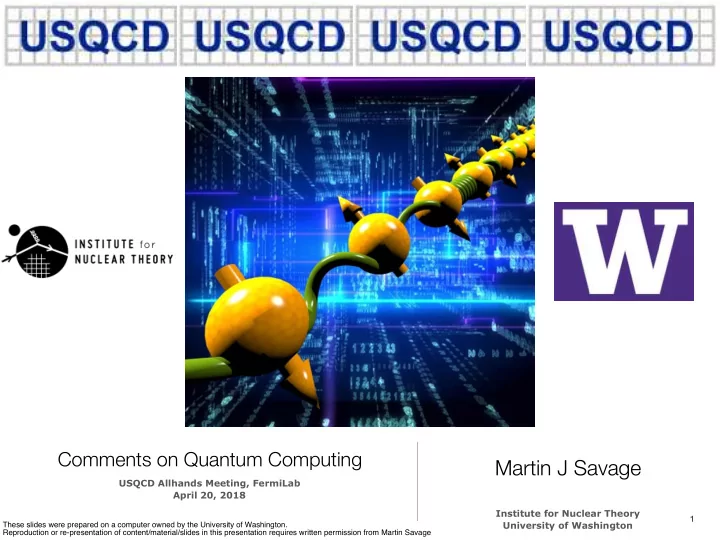

Comments on Quantum Computing Martin J Savage USQCD Allhands Meeting, FermiLab April 20, 2018 Institute for Nuclear Theory 1 University of Washington These slides were prepared on a computer owned by the University of Washington. Reproduction or re-presentation of content/material/slides in this presentation requires written permission from Martin Savage
Q: Why should we think about QC ? A: We have Beyond-Exascale Challenges • Signal-to-Noise = Sign Problem (Derek Leinweber, U. of Adelaide) • Large-scale contractions • Sign Problem
Fragmentation Vacuum and In-Medium Currently - out of scope • Free-space and in-medium • Diagnostic of state of dense and hot matter • heavy-ion collisions (e.g., jet quenching) • finite density and time evolution • Highly-tuned phenomenology and pQCD calculations
Why Quantum Computing? The sign problem and the desire for dynamical evolution of QCD systems, requiring beyond exascale classical computing resources, lead us to consider the potential of quantum information and computing. [2016-2017] Workshop on Computational Complexity Quantum Computing for Nuclear Physics Near-term Applications of Quantum and High Energy Physics November 14-15, 2017 Computing, December 6-7, 2017 July-31 — August 2, 2017 Intersections Between Nuclear Physics and Quantum Information March 28-30, 2018 Image made by Dave Wecker @ Microsoft Institute for Nuclear Theory (2017)
Quantum Computing 53 qubits !! Maryland Caltech 5
Quantum Computing 6
Quantum Computing - some of the hardware D-wave : ~ 2000 qubits Google : 72 superconducting qubits - not accessible at present IBM : superconducting - 5, 5, 16, 20, 56 qubits systems - cloud access Intel : 49 superconducting qubits - test chip IonQ : trapped ions, 53-qubit system, cloud access coming Microsoft : Majorana - nothing available yet Rigetti : 19 superconducting qubits 7
The promise of Quantum Computing Parallel Processing e.g., for a 3-bit computer (2 3 states) Classical computer in 1 of 8 possible states Quantum computer could be in all states at once! • > ~ 50 qubits : at capabilities of leadership class computers 8 • 300 qubits : more states than atoms in universe
Molecules 9
time=0 for Quantum Computing in Nuclear Physics Nuclear Physics http://arxiv.org/abs/1801.03897 10
Quantum Field Theory with Quantum Computers - Foundational Works Phys.Rev. A73 (2006) 022328 Quantum Information and Computation 14, 1014-1080 (2014) Detailed formalism for 3+1 quenched Hamiltonian Gauge Theory 11
Quantum Field Theory - recent examples arXiv:1704.02877 arXiv:1702.05492 proposed method arXiv:1712.09362 [hep-th] arXiv:1802.07347 [quant-ph] arXiv:1803.11166 [hep-lat] 12
Starting Simple 1+1 Dim QED - Pivotal Paper (2016) Based upon a string of 40 Ca + trapped-ion quantum system Simulates 4 qubit system with long-range couplings = 2-spatial-site Schwinger Model > 200 gates per Trotter step 13
Gauge Field Theories e.g. QCD Natalie Klco 32 3 lattice requires naively > 4 million qubits ! State Preparation - a critical element | random > = a |0> + b |(pi pi)> + c | (pi pi pi pi ) > + …. + d | (GG) > + …. Conventional lattice QCD likely to play a key role in QFT on QC 14
ASCR supported QC for QFT DOE-ASCR Heterogeneous Digital-Analog Quantum Dynamics Simulations Methods and Interfaces for Quantum Acceleration of Scientific Applications
Starting Simple 1+1 Dim QED Construction • Charge screening, confinement • fermion condensate Derek Leinweber Natalie Klco Quantum-Classical Dynamical Calculations of the Schwinger Model using Quantum Computers 16 N. Klco, E.F. Dumitrescu, A.J. McCaskey, T.D. Morris, R.C. Pooser, M. Sanz, E. Solano, P. Lougovski, M.J. Savage. arXiv:1803.03326 [quant-ph]
Starting Simple 1+1 Dim QED Symmetries 3.5 3.0 V - V - Threshold 2.5 S + 2.0 Δ E V - 1.5 1.0 0.5 0 • Gauss’s Law π =+ 1 π =- 1 • (Angular) Momentum • Parity Classical pre-processing Can this be done in situ ? Classical post-processing 17
Starting Simple 1+1 Dim QED Living NISQ - IBM Classically Computed U(t) ibmqx2 - cloud-access 8K shots per point 18 Cartan sub-algebra
Starting Simple 1+1 Dim QED Living NISQ - IBM Trotter U(t) 3.6 QPU-s and 260 IBM units 19 [ ``Capacity computing’’ - required only 2 of the 5 qubits on the chip - 5 CNOT gates per step]
Hamiltonian to Circuit Trotter 20
Cloud Access to NISQ devices Chroma Vs Python3 Lattice QCD application chroma code written by Savage (2012) for NPLQCD, Python3 code written by Savage (2018) to access IBM quantum devices through adapted from other chroma codes written by Robert Edwards and Balint Joo [JLab, ``the cloud’’ (through ORNL). IBM templates and example codes. USQCD, SciDAC]. Calculates Trotter evolution of +ve parity sector of the 2-spatial-site Schwinger Model. c++ 21 Displaced propagator sources generate hadronic blocks projected onto cubic irreps. to access meson-meson scattering amplitudes in L>0 partial waves.
Quantum Field Theory and Quantum Information Are there new insights into the forces of nature and/or calculational techniques to be had by thinking in terms of quantum information? Preskill, Swingle, Hsu, and others Entanglement entropy in scattering (tensor networks) New ways to arrange QCD calculations ? New ways to address QCD analytically ? Entanglement in HEP and NP systems is starting to be considered 22 Pichler et al. (2016)
Possible Near Future ? QPU accelerators ? 23
Summary • Finite density systems, larger nuclei , and dynamics require beyond-exascale calculations. • Quantum Information Science and Quantum Computing offer the possibility of providing a Quantum Advantage for QCD. • Collaborations between universities, national laboratories and technology companies now forming around QIS, QC and the domain sciences • Wise for USQCD to consider near-term quantum possibilities - algorithms and code for QPUs
FIN
Recommend
More recommend